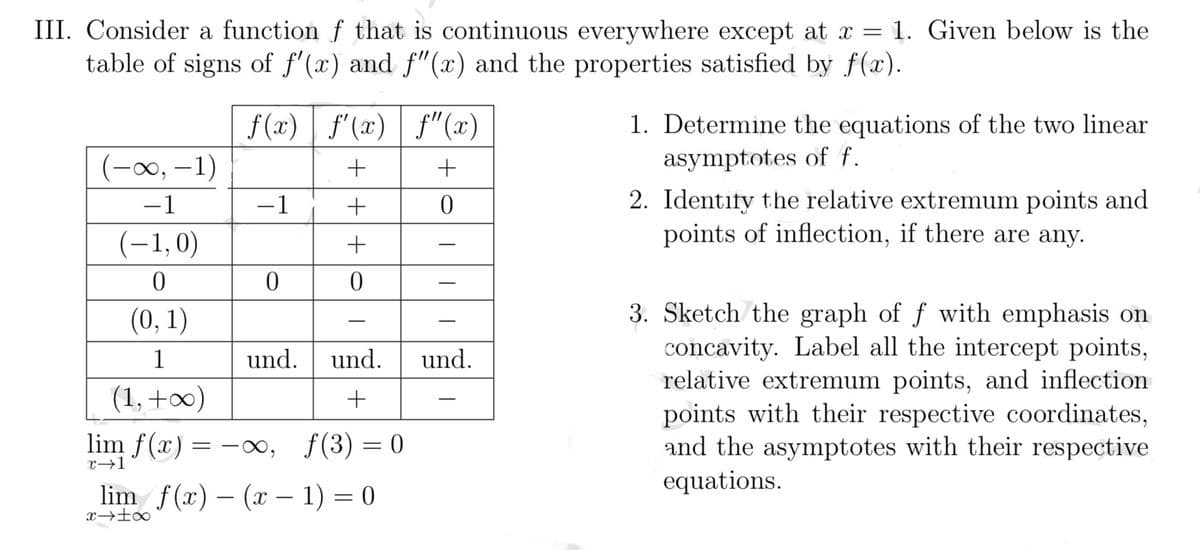III. Consider a function f that is continuous everywhere except at x = 1. Given below is t table of signs of f'(x) and f"(x) and the properties satisfied by f(x). (-∞, -1) -1 (-1,0) 0 f(x) f'(x) + + + 0 -1 0 (0, 1) 1 (1, +∞) lim f(x) = -x, f(3) = 0 r⇒1 - und. und. + f"(x) + 0 - - und. 1. Determine the equations of the two line asymptotes of f. 2. Identity the relative extremum points a points of inflection, if there are any. 3. Sketch the graph of f with emphasis concavity. Label all the intercept poin relative extremum points, and inflecti points with their respective coordinat and the asymptotes with their respecti
III. Consider a function f that is continuous everywhere except at x = 1. Given below is t table of signs of f'(x) and f"(x) and the properties satisfied by f(x). (-∞, -1) -1 (-1,0) 0 f(x) f'(x) + + + 0 -1 0 (0, 1) 1 (1, +∞) lim f(x) = -x, f(3) = 0 r⇒1 - und. und. + f"(x) + 0 - - und. 1. Determine the equations of the two line asymptotes of f. 2. Identity the relative extremum points a points of inflection, if there are any. 3. Sketch the graph of f with emphasis concavity. Label all the intercept poin relative extremum points, and inflecti points with their respective coordinat and the asymptotes with their respecti
College Algebra (MindTap Course List)
12th Edition
ISBN:9781305652231
Author:R. David Gustafson, Jeff Hughes
Publisher:R. David Gustafson, Jeff Hughes
Chapter3: Functions
Section3.3: More On Functions; Piecewise-defined Functions
Problem 99E: Determine if the statemment is true or false. If the statement is false, then correct it and make it...
Related questions
Question

Transcribed Image Text:III. Consider a function f that is continuous everywhere except at x = 1. Given below is the
table of signs of f'(x) and f"(x) and the properties satisfied by f(x).
(-∞, -1)
-1
(-1,0)
0
(0, 1)
1
(1, +∞)
f(x) f'(x)
|
+
+
+
0
-1
0
und. und.
+
lim f(x) = -∞, f(3) = 0
x⇒1
lim f(x) (x - 1) = 0
x→±x
f"(x)
+
0
und.
1. Determine the equations of the two linear
asymptotes of f.
2. Identity the relative extremum points and
points of inflection, if there are any.
3. Sketch the graph of f with emphasis on
concavity. Label all the intercept points,
relative extremum points, and inflection
points with their respective coordinates,
and the asymptotes with their respective
equations.
Expert Solution
This question has been solved!
Explore an expertly crafted, step-by-step solution for a thorough understanding of key concepts.
Step by step
Solved in 3 steps with 3 images

Recommended textbooks for you

College Algebra (MindTap Course List)
Algebra
ISBN:
9781305652231
Author:
R. David Gustafson, Jeff Hughes
Publisher:
Cengage Learning


College Algebra (MindTap Course List)
Algebra
ISBN:
9781305652231
Author:
R. David Gustafson, Jeff Hughes
Publisher:
Cengage Learning
